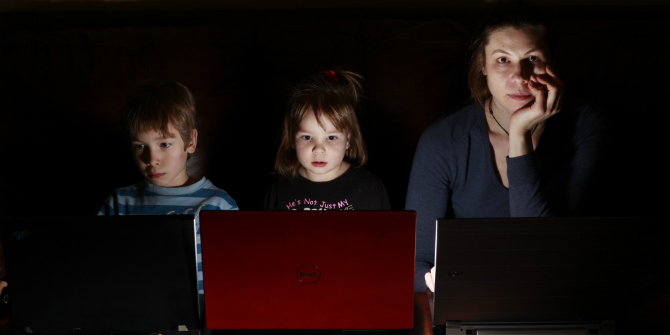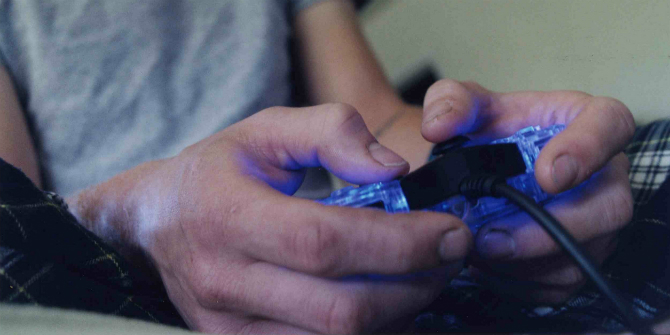 To mark Safer Internet Day, this post takes a look at Ofcom’s latest reports into children’s media use and discusses how a decline in family viewing impacts on what strategies parents can use to ensure that their children stay safe online. Gianfranco Polizzi and Kate Gilchrist suggest that while screen time rules are popular, having regular conversations with children may be more effective. Gianfranco and Kate are both third-year PhD researchers at the Department of Media and Communications, LSE.
To mark Safer Internet Day, this post takes a look at Ofcom’s latest reports into children’s media use and discusses how a decline in family viewing impacts on what strategies parents can use to ensure that their children stay safe online. Gianfranco Polizzi and Kate Gilchrist suggest that while screen time rules are popular, having regular conversations with children may be more effective. Gianfranco and Kate are both third-year PhD researchers at the Department of Media and Communications, LSE.
Parents are increasingly concerned about their children’s TV and online viewing habits but are struggling to adequately mediate their media use. According to new reports from Ofcom [1], the major concerns for parents are screen time and a lack of control over what their children are watching, as they are increasingly viewing content using personal devices such as tablets. While parents are addressing this by creating screen time rules, such rules are not fully effective. In addition, there is a particular lack of mediation of teens’ media use, with parents trusting those aged 12-15 to exercise their own judgement, or relying on schools to teach them about internet safety. While media corporations and platform providers also share a responsibility for protecting children from harmful content, this post focuses on what role parents can play in ensuring children are protected. We argue that parents’ mediation practices must adapt to accommodate such developments in technology and viewing habits. We suggest that encouraging parents to have more conversations about internet safety is important in ensuring their children’s safety.
A move away from shared viewing towards individual devices
Viewing habits are shifting as young people increasingly move away from watching broadcast TV together on family TV sets towards a more individualised, solitary content-viewing via streaming services such as Netflix and YouTube. For example, half of 5- to 15-year-olds now watch services such as Netflix, Amazon Prime and Now TV. As a result, parents have fewer opportunities to directly monitor what children are watching, and children have more control and choice over content. Yet new media formats are also providing the opportunity for children to produce and create their own content. YouTube is becoming the viewing platform of choice – as the graphs below show, 49% of those aged 8-11 and 12-15 prefer to watch YouTube over normal TV, an increase on 2017. 
One of the many reported appeals of YouTube are that it allows them to develop their offline interests and hobbies, with crafting videos and tutorials being popular genres. So how can parents address this shift in control?
Parents’ mediation strategies – just a matter of trust?
Ofcom’s report states that “nearly all parents of 3-4s and 5-15s (97%) mediate their child’s use of the internet in some way, either through technical tools, supervision, rules or talking to their child about staying safe”. As discussed above, however, supervision is becoming a more difficult way to mediate children’s media consumption due to changes in viewing habits. And while almost 80% of parents of 5- to 15-year-olds feel that they “know enough to help their child stay safe online”, only 38% use PINs on their TV service.
The Children’s Media Lives report indicates that there is a risk that children who use non-age-restricted family Netflix accounts can be exposed to adult content. But such a risk is not necessarily related to parents’ (in)ability to set parental controls. A recent survey by Internet Matters indicates that only one in 10 parents in the UK do not set parental controls because “they are too complicated”. And although parents of 3-4s and 5-15s were less aware of content filters in 2018 than in 2017 (i.e. 51% and 57% respectively in 2018 as opposed to 66% and 62% in 2017), Ofcom suggests that half of parents of 5-15s who know about content filters deliberately choose not to use them because they prefer using rules or having conversations with their children.
However, not only can rules be broken, they are also likely to fail, especially when based on restricting children’s time spent on digital devices such as smartphones and tablets. According to Ofcom, children do not consistently follow their parents’ rules to limit screen time. In addition, 70% of 12- to 15-year-olds who have a smartphone are allowed to take it to bed, making it harder for parents to mediate their children’s online engagement. But this is not necessarily a problem. As argued by Sonia Livingstone and Alicia Blum-Ross, while screen time is often perceived as inherently worrisome by academics, parents and policy makers, what matters is not so much the quantity but the quality of what children watch and do online and offline.
Ofcom suggests that while 81% of parents of 5- to 15-year-olds have talked to their children about internet safety, parents of 12- to 15-year-olds were less likely to do so in 2018 compared to 2017 (87% and 92% respectively). Relatedly, 12- to 15-year-olds were less likely to report having received advice from a parent (71% in 2018 as opposed to 83% in 2017). Instead, parents of older children, as shown by the Children’s Media Lives report, tend to trust them when they use the internet, or they trust schools to adequately cover internet safety. But the UK Safer Internet Centre reminds us that:
“approaches to internet safety education may be having little effect in changing the knowledge and practice of young people […as there are] no established standards […for] assess[ing] learning and progress”.
Therefore, while it is paramount that parents trust their children for a healthy parent-child relationship, trust in their ability to do what’s best or in the education system should not overshadow the importance of mediating what they watch and do online by having regular conversations with them. However, parents are not always equipped with knowledge about screen time and internet safety and there is a lack of evidence-based resources and advice available to them.
Fewer screen-time rules, more conversations
As the viewing landscape in the digital age is giving more control to children over what they watch and do online, making it harder for parents to mediate children’s media use, it has never been more important for parents to have conversations with their children. Hence, our advice is as follows:
- Parental controls are helpful in ensuring that children do not come across inappropriate content on platforms such as Netflix and YouTube. But parental controls are not (and cannot be) the only solution.
- Screen-time rules based on how many hours children spend online are likely to fail as what matters is not so much the quantity but the quality of what they do online and offline.
- As children’s engagement with online content is increasingly individualistic, having regular conversations with children on internet safety and what they do online is perhaps the best way for parents to make sure that they are safe and that they are using the internet constructively. A good way to start is to ask children, for instance, what sites they enjoy visiting, how they stay safe online and whether they know where to go for help.
- More evidence-based resources and advice are needed for parents on how to mediate their children’s online engagement.
Notes
[1] The findings are drawn from Ofcom’s (the UK’s communications regulator) latest reports, released last week. Children and Parents: Media Use and Attitudes 2018 is based on quantitative findings gathered from children aged 5-15 about their use of and attitudes towards media, as well as parents’ views on their children’s media use. A more detailed analysis into media habits was carried out on children age 3-4. The report also drew on qualitative data from Ofcom’s Children Media Lives study, which examined in depth the actual media practices of those aged 8-18, through techniques such as screen recording and social media tracking, alongside interviews with children. The Revealing Reality report involved interviews with 40 children aged 4-16, who kept diaries of their viewing habits for one week, allowing a comprehensive account of what children are watching and why.
This post gives the views of the authors and does not represent the position of the LSE Parenting for a Digital Future blog, nor of the London School of Economics and Political Science.





